Home
Radio Латвия (Riga) M 137
- Details
- Category: Gallery
- Hits: 3330
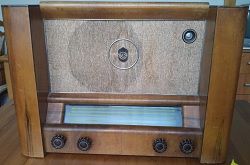
The concept of the radio receiver was developed in 1947. Its mass production, however, began much later, in September 1950. In 1952 the radio underwent some modifications and was sold under the name Mir M 152. I have no idea what the modifications were. I have not found any reliable information on this. Some detailed information about the radio can be found on the page M137. According to the content given there:
"One of the features of the Latvian radio receiver M 137 is the scale in which the sight is combined with the indicator of the range switch. In each of the 5 bands, a bright dot on a red background indicates the tuning frequency of only the selected band. The line goes off in reception mode. Radio speaker - 10GDP-VEF (10 W) with a 250 mm diffuser. Among the creators of this radio was Gintauts Aboltins-Abolins, later a well-known constructor of the Orbita design office, and from 1968 the head of the Department of Design and Production Technology of Electronic Devices at the Radio Engineering Faculty of the Riga University of Technology.
In the Vefietis newspaper you can find articles about console radios based on the Latvija M137 receiver. One carries the inscription "To my dear leader, father and teacher Józef Vissarionovich Stalin on the 30th anniversary of the Komsomol from Komsomol members and youth of Riga." Another one was created on the occasion of the 10th anniversary of the LSSR in July 1950."
The radio is impressive. When I was in his possession, my reaction was clear.

Photo 1. I tried to whistle, of course, but my mouth was dry with admiration.
I showed the radio to cats, which usually hang around, and unfortunately I was a bit disappointed. Their reaction was quite different. They did not even deign to leave the armchair:

Photo 2. The one above is Cypis, the one below is Deedee (second name ZEA). Cats are said to sleep 70% of their lives. Cypis sleeps 95%.
Let us return, however, to the topic of description. Here is the radio in all its glory.
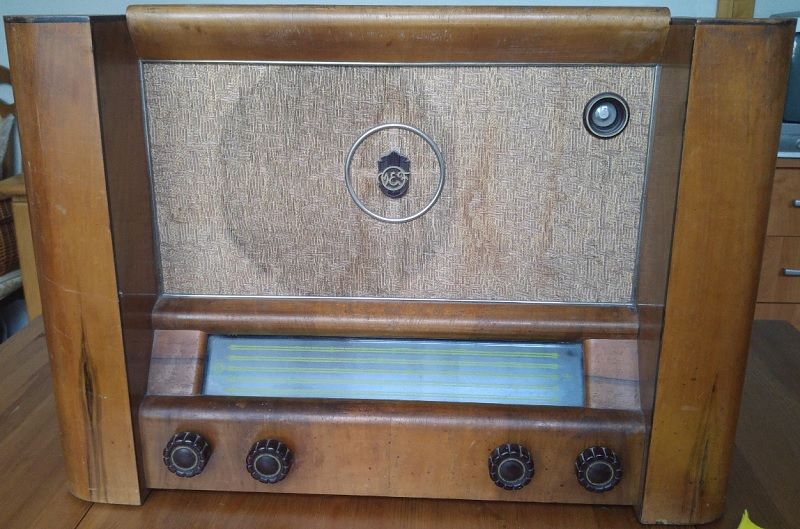
Photo 3
Basic parameters:
- Sensitivity: not less than 50 μV
- The output power of 6 W in the frequency range 60 Hz ÷ 6500 Hz
- Power drawn from the network: 190 W
- Supply voltage: 110V / 125V / 220V
- Dimensions: 642 mm / 406 mm / 292 mm
- Weight: 30 kg (I found out about it turning the radio while taking the photos below).
More detailed data:
- Ranges:
- Long waves: 150 kHz ÷ 410 kHz (2000 m ÷ 730 m)
- Medium waves: 520 kHz ÷ 1500 kHz (577 m ÷ 200 m)
- Short wave I: 4.28 MHz ÷ 8.57 MHz (70 m ÷ 35 m)
- Short wave II: 8.53 MHz ÷ 12.2 MHz (35.2 m ÷ 24.6 m)
- Short waves III: 15.07 MHz ÷ 15.54 MHz (19.9 m ÷ 19.3 m)
- Intermediate frequency: 465 kHz.
- Tubes used: 6K7 x 3, 6A7, 6A8, 6X6C, 6C5, 6H7C, 6P3C x 2, 6E5C, 5Ц4С x 2
Now it remains to sit comfortably, stock up on a suitable drink (of course I mean mineral water) and look at the photos. Remember how much effort it took to turn this 30-kilogram monument of radio technology.
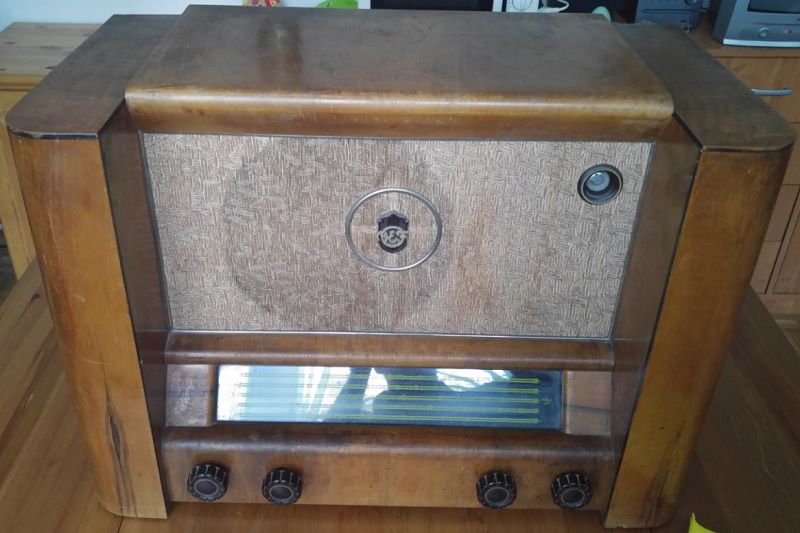
Photo 4. One more shot from the front (from a different angle).
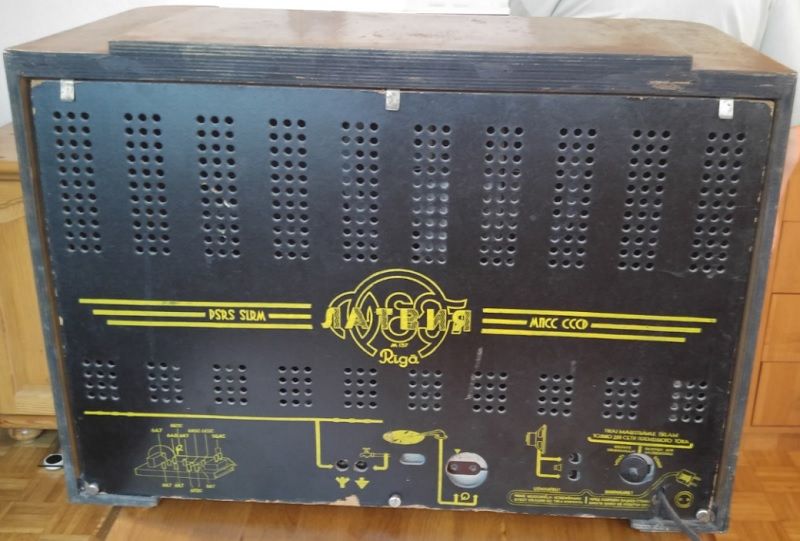
Photo 5. And it was not without a shot from the so-called "ass" side. Wonder!!!
And now it's time for a few dozen, I repeat SEVERAL dozen photos. Some are not much different except for a different camera angle. But since I've worked with them, why not put them in the Gallery.
Radioamator (Radio Amateur) 1955/03
- Details
- Category: Radioamator
- Hits: 2233

YEAR V, MARCH 1955, No. 3
- YOUTH AS THE SOURCE OF RADIO-AMATEUR MOVEMENT (1)
"Our whole society followed with great interest the course of the several-day deliberations at the recently convened 2nd Congress of the Polish Youth Union, which gathered in Warsaw hundreds of delegates from all over the country, outstanding activists of the young generation of People's Poland. The radio and the press devoted a lot of attention to this event, so close to us, and popularized it sufficiently. We listened intently to the speeches and statements made at the meeting, the words of criticism and words of appreciation for our self-sacrificing and ideologically tight Zetempo youth..." - BATTERY RECEIVER WITH 3 ELECTRON TUBES (2)
"We provide a description of a 3-tube battery receiver adapted to work in the mid-wave (200 ÷ 570 m) and long-wave (730 ÷ 2000 m) range, characterized by high economy in electricity consumption. After turning off the loudspeaker lamp, the device allows reception on the headphones, and after completely turning off the battery and inserting the crystal, it can be used as a detector receiver..."
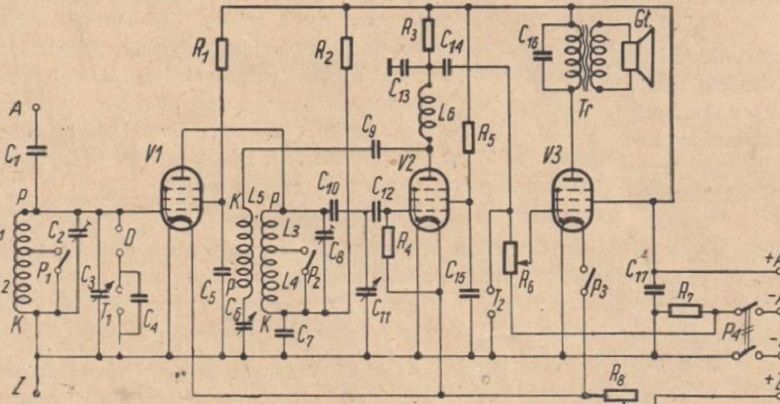
Schematic diagram of the receiver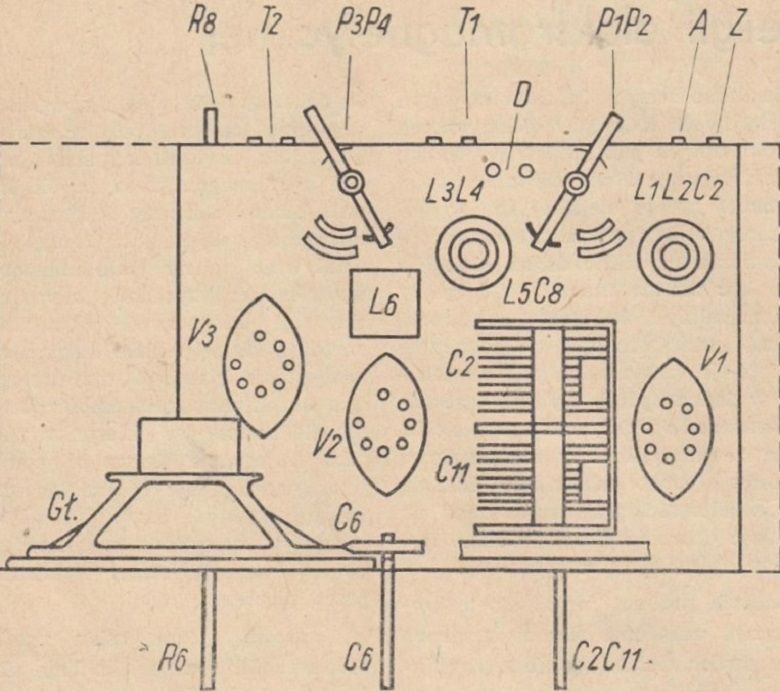
Placing the essential parts on the chassis
- THE ESSENCE OF ELECTROMAGNETIC WAVES (6)
"Space, one form of the material world, has a strange quality. Namely, a body placed in space may be subjected to a specific mechanical force, although no other body is in its immediate vicinity..." - HOW I BECAME THE POLISH REPRESENTATIVE? (9)
"A. SUCHETA SP9-107. I encountered telegraph for the first time at the Provincial Communications Club of the League of Friends of Soldiers in Krakow in February 1953. I noticed that learning the Morsa signs was very good and fast, which encouraged me to work on increasing the speed of reception. It coincided with the first listening sessions that I began to carry out from the moment when I was already able to distinguish individual letters and numbers broadcast by amateur stations, of course the slowest ones. I carried out a lot of listening in a short time, and these mainly contributed to my further success, that is, to receive stations transmitting at up to 100 characters per minute...
" - DESIGNING A DIRECTIONAL VHF ANTENNA - completion (10)
"The last stage of antenna design includes the antenna feed line, the so-called "Feeder". For the correct design of this line, it is necessary to know the antenna radiation resistance. In the case of a single dipole, i.e. a half-wave element, placed in free space, the radiation resistance related to the antenna center, i.e. the head of the current, is 73.2 Ω..." - VHF transmitter 420 ÷ 460 MHz (13)
"In September 1954, trials of amateur shortwave communication took place, in which the SP5KAB station set up on Śnieżnik in the Kłodzko Mountains participated. These tests, organized by the Czechoslovakian SVAZARM, were carried out on the 420 and 1215 MHz bands. One of the transmitters working there - due to its simplicity and the results achieved - deserves special attention. Here is its description..." - ON AMATEUR BANDS (15)
"In the period from mid-January to mid-February, there was a certain further increase in the activity of Polish stations in the air..." - "REMBRANDT" TYPE FE 852 B TV RECEIVER (15)
"The "Rembrandt" television set, produced by the Sachsenwerk plant in the GDR, is one of the latest achievements of the GDR television technology and, thanks to its relatively low price, makes it possible to popularize television among the general public. This television with a screen with dimensions of 180 x 240 mm on a picture lamp type HF2963 is designed to receive the Berlin and Leipzig broadcasting stations, and also provides the reception of ultra-short stations in the VHF band with frequency modulation..." - BEFORE THE "POLNI DEN" COMPETITION - SP5FM (19)
"The results of the ultra-shortwave competition "Polni Den 1954" were announced in the January issue of AMATERSKE RADIO. 124 radio teams out of 137 entered took part in them. A total of 1,189 operators, including 87 women, participated in the competition..." - "STERN" 7E86ARECEIVER (20)
"Among the new receivers, imported and recently distributed on the market, the receiver produced by the GDR Stern 7E86A deserves attention. It is characterized by a modern construction, good acoustics and effective workmanship. Built in a 7-tube superheterodyne system, it allows the reception of waves with amplitude modulation (AM) and frequency modulation (FM system)..." - PRINCIPLE OPERATION OF RADIOLOCATION DEVICES (RADAR) (22)
"The radar devices described here have little to do with television, although there is an analogy between them.
Burdjak Area-41
- Details
- Category: Amplifiers
- Hits: 2501
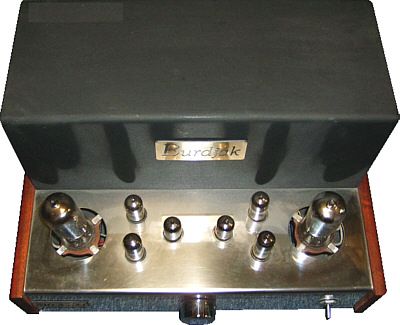
Grzegorz "gsmok" Makarewicz,
I present the photo documentation of the Burdjak Area-41 tube amplifier. It is a stereo amplifier made on triodes 6S41S (6C41C) operating in an unbalanced configuration (SE). The applied power tubes are relatively rare in designs available on the market. The situation is different with DIY amplifiers. In this group the 6S41S tube, which is a kind of "anemic" cousin of the 6S33S tube (the popular "devil"), is more often used. If you are interested in detailed parameters, I encourage you to familiarize yourself with the catalog cards of these tubes.
The 6S41S tubes in the Area-41 amplifier provide a really nice listening experience - this is of course only my subjective opinion. I took the posted photos during the repair of the amplifier. I present them in the order in which I made them while creating documentation for my collection. Please see the details of the structure. I warn people about problems with hypertension in advance that as the amplifier is disassembled and its construction details are revealed, the photographs reveal its darker and darker secrets. Well, after all, this is not a factory amplifier made by a manufacturer with good machinery. However, this does not change the fact that apart from the undoubtedly many advantages, the amplifier uses ideas that call for vengeance to heaven.
Radioamator i Krótkofalowiec (Radio Amateur & Short-waver) 1968/04
- Details
- Category: Radioamator i Krótkofalowiec
- Hits: 1826
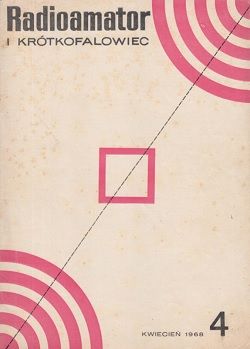
YEAR 18 - APRIL 1968 - No 4
- FROM THE COUNTRY AND ABROAD
- Belgian Technology Week in Warsaw (77)
"On January 15-21 this year, the Belgian Foreign Trade Office, in cooperation with the Supreme Technical Organization (NOT), organized an exhibition and a series of papers at the Museum of Technology at the Museum of Technology as part of the Belgian Technology Week, presenting the achievements of the Belgian industry, especially in the fields of nuclear energy, reactors, plutonium production, and chemicals and plastics, as well as electronic measuring equipment..." - An exhibition of Czechoslovak radio and television equipment (77)
''On February 12 - 19 this year, in the Czechoslovak Culture Center in Warsaw, the KOVO commercial headquarters demonstrated the latest models of equipment manufactured by the well-known company TESLA..." - News from the Hungarian industry (78)
"The Hungarian electronic industry in search of sales markets cooperates with many foreign companies, using their licenses and documentation, as well as supplements its devices with components of a global brand..."
- Belgian Technology Week in Warsaw (77)
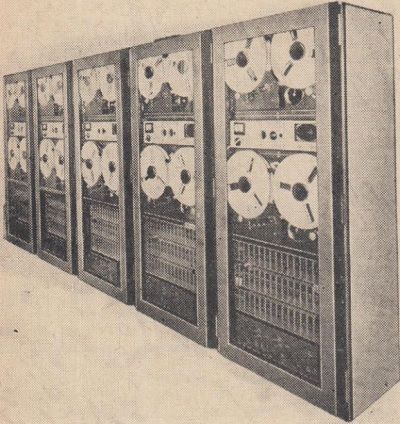
8 - 16 - channel SHR-8-16 type tape recorder for recording the course of airplane - air tower conversations
- Interesting facts from Japanese electronics (78)
"Electronic watches promise a revolution in the manufacture of watches. The fantastic accuracy (e.g. 1 second delay per month) of handwatches based on the quartz oscillator and integrated circuit technology will in the future shift watches with mechanical drive and mechanical stability to a background.
The Japanese company SUWA SEIKOSHA has developed a prototype of a manual watch based on the technique of integrated circuits..."
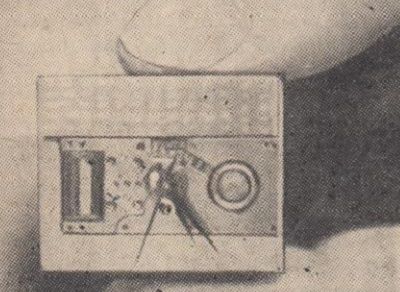
Electronic watch from SUWA SEIKOSHA
- ELECTRONIC SYSTEMS ON ELECTRON TUBES
- Radio receiver with aperiodic FM demodulator (79)
"For a long time, the development of electro-acoustic devices has been aimed at ensuring the best possible quality of broadcasting. Such devices, known as Hi-Fi devices, must, inter alia, have a wide acoustic frequency response, high sound dynamics, low harmonic content, low level of mains hum and noise... "
- Radio receiver with aperiodic FM demodulator (79)
- SEMICONDUCTOR TECHNIQUE
- Silicon epiplanar transistors (Conclusion on 3/68) (83)
"Silicon epiplanar transistors are usually manufactured as n-p-n transistors by the diffusion doping method using the masking effect of silicon dioxide...
- Silicon epiplanar transistors (Conclusion on 3/68) (83)
- MEASUREMENT TECHNIQUES
- Oscilloscope measurement of the static characteristics of transistors (Ending from number 3/68) (86)
''' Switching circuits are perfect for producing stepped waveforms. Depending on the number of flip-flops (n) used, when they are connected in series, N = 2n equilibrium states can be obtained..."
- Oscilloscope measurement of the static characteristics of transistors (Ending from number 3/68) (86)
- OVERVIEW OF THE SCHEMES
- "Atol 19" television receiver (89)
Read more: Radioamator i Krótkofalowiec (Radio Amateur & Short-waver) 1968/04
- "Atol 19" television receiver (89)
Nowy Elektronik (New Electronics) 2003/4
- Details
- Category: Nowy Elektronik
- Hits: 1930

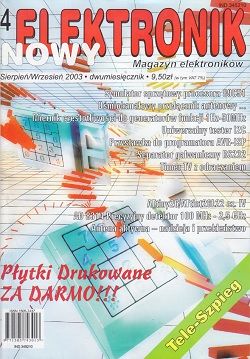
- Microprocessor systems
- 89C51 microcontroller hardware simulator (4)
"The simulator allows you to reduce the time of writing software to a minimum. Programming the simulator is done from the COM connector. Thanks to this solution, we do not have to remove and insert the microcontroller into the programmer each time, and then into the system being started..." - Eight-channel antenna switch for radio amateurs and amateurs (7)
"The switch enables one good quality coaxial cable to connect up to 8 antennas to one transceiver. The antenna switching is controlled by a cheap three-wire electric cable..." - Active antenna - hope and curse (12)
"We often encounter difficult reception of radio and television programs. After the hardships and struggles, we buy an active antenna, which helps in some conditions, but in others it is even worse. In this article, I would like to answer the question - what does it depend on? An active antenna, contrary to the usual one, has its own rules, and breaking one canon causes very unpleasant consequences not only for the owner, but also for the environment..." - Frequency meter for function generators 1 Hz ÷ 50 MHz (14)
"A function generator without a frequency meter is only half a generator. The designed meter enables the measurement of TTL signals with a frequency from 1 Hz to 50 MHz, which is perfect for a workshop function generator..." - Universal I2C tester (17)
"More and more integrated circuits are equipped with an I2C interface. The proposed tester allows you to test any system with the I2C interface. All you need is a computer running any terminal, some time and of course a universal I2C tester to test or check the operation of any system..." - Adapter for the AVR-ISP programmer (27)
"The adapter is used to program AVR microcontrollers in a DIP housing. It is an indispensable tool when programming more AVRs with the same data. Works with the professional programmer AVR-ISP set 326-K..." - Tele - spy (38)
"Eavesdropping on telephone conversations is nothing new. On the other hand, wiretapping the number dialed always aroused a lot of emotions. Tele-spy allows you to identify the numbers that the household members call, provided that we have a telephone set with tone dialing - DTMF..."
- 89C51 microcontroller hardware simulator (4)
- Electronic circuits
- Galvanic RS232 separator (36)
"As the name suggests, the system is used to separate the galvanic RS232 connector in the computer from the connected device. The separator is necessary when starting systems cooperating with the RS232 connector. It can be used with any type of computer equipped with the above connector..." - TV timer with deferment (20)
"During the operation of the TV set, it emits a lot of heat, this especially applies to older models.
- Galvanic RS232 separator (36)
Nowy Elektronik (New Electronics) 2001/2
- Details
- Category: Nowy Elektronik
- Hits: 1897

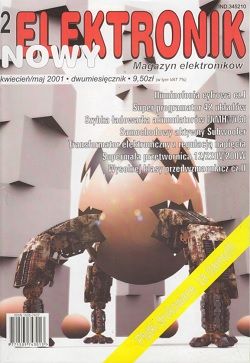
- Microprocessor systems
- Super programmer of 42 chips (4)
- "According to the above title, the programmer allows you to program 42 types of different memories and microprocessors. The group of programmable devices includes: PIC12C5xx, 12C76x, 24Cxx, 16C55x, 16C61, 16C62x, 16C71, 16C71x, 16C8x, 16F8x..."
- Digital Illuminophony Part I. (6)
"Digital illuminophony is a system that allows you to control three light sources - light bulbs to the beat of the music. The difference between analog and digital illuminophony is in the quality of the lighting effects. Of course, digital gives you a more unforgettable experience..."
- Audio circuits
- High-class preamplifier with microprocessor control part II (9)
"The first part describes the construction of the preamplifier. In the second and last part, we will deal with the assembly, commissioning and use of the preamplifier..."
- High-class preamplifier with microprocessor control part II (9)
- Electronic circuits
- Super small 12 / 220V / 200W converter (12)
"The presented converter was built on the specialized SG3525 chip from SGS. This solution made it possible to reduce the size of the converter to a minimum while maintaining significant power, as much as 200 W..." - Electronic transformer with voltage regulation (15)
"Traditional transformers are increasingly being replaced by electronic transformers in the consumer goods. We also decided to design and manufacture such a transformer. The presented transformer is ideal for powering halogen bulbs with a power from 20 W to 60 W. Additionally, the transformer has an output voltage regulation..." - Car Active Subwoofer (18)
"More and more drivers also want to listen to good quality music in their car. Unfortunately, even expensive cars usually do not have too sophisticated audio equipment. That is why we decided to develop a high-class, yet easy-to-build car Subwoofer..." - Fast charger for NiMH / NiCd batteries (22)
"NiMH and Nicd batteries are increasingly replacing ordinary batteries. However, in order for the battery to retain its service life for a long time, it must be charged properly. The presented charger, in addition to optimal charging, has one more important feature, which is the speed of charging an exhausted battery..."
- Super small 12 / 220V / 200W converter (12)
- Electronic components
- AD7492 - 12-bit A / D converter 926)
- AD5235 - Non-volatile, two-channel, 1024 - position digital potentiometer (26)
Radioamator (Radio Amateur) 1955/02
- Details
- Category: Radioamator
- Hits: 1985
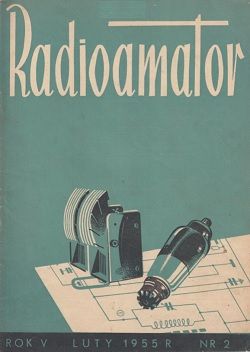
- ON THE SOCIAL CHARACTER OF RADIO-AMATEUR WORK (1)
"PEOPLE'S POLAND has created the best conditions for the development of the amateur radio movement. It also surrounds - on a par with other branches of technology or science - with caring care, sparing no support and resources for the widest possible massization of radio amateur creativity and constantly raising it to a higher and higher ideological and technical level..." - INTERNATIONAL RADIO-TELEGRAPHIC COMPETITION IN LENINGRAD - M. Konieczny (3)
"ACCORDING to the announcement in the January issue of RADIOAMATOR, we provide further details on the International Radiotelegraph Competition, which took place in Leningrad from November 18 to 28, 1954..." - THE ESSENCE OF ELECTROMAGNETIC WAVES - M. R. (5)
"For those learning the basics of radio technology, the greatest difficulty is usually to understand the essence of radio waves, and in general the essence of electromagnetic waves. It is understandable, taking into account that radio waves - without affecting our senses directly - are imperceptible, imperceptible by us. In addition, the radio engineering section devoted to the essence of radio waves is generally not dealt with exhaustively in textbooks..." - HIGH FREQUENCY INDUCTORS - mgr inż. K. Lewiński (7)
"If high-frequency chokes have almost completely disappeared from radio receivers, they are still widely used in radio transmitting equipment. The main place of work of RF reactors is the anode circuit of the RF power amplifier, as well as their grid circuit..." - AMATEUR TAPE RECORDERS HEADS - inż. A. OWCZAREK (10)
"HEADS are among the most sensitive and essential elements of a tape recorder. They represent an electromagnet with a core made of iron-nickel alloy plates with high magnetic permeability and low coercivity. The core consists of symmetrical halves; each of them has a coil in half winding..." - DESIGNING A DIRECTIONAL VHF ANTENNA (part I) - mgr inż. Z. Kachlicki (14)
"WORK in the field of VHF creates an opportunity, among others also for close contact with directional antennas. The construction of such antennas for the short-wave range, although very desirable, causes considerable difficulties in amateur conditions due to their large dimensions resulting from the considerable short-wave length..." - RADIO RECEIVER "SYRENA" - A. S. (16)
"Manufactured by the domestic industry, the "Syrena" receiver is a mid-class 6-circuit superheterodyne (four intermediate frequency circuits factory tuned at 468 kHz, a single input circuit and one oscillator tuned circuit)..."
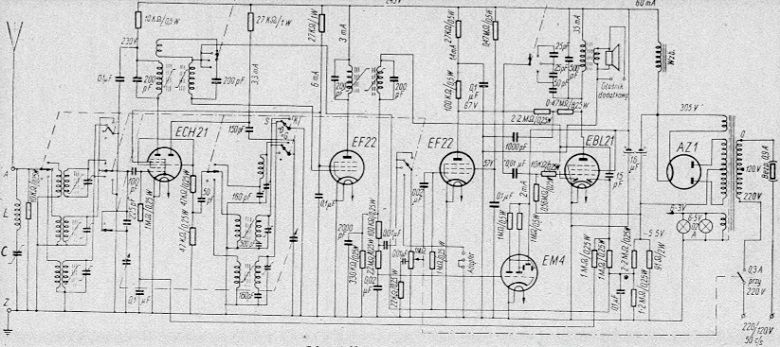
Schematic diagram of the receiver 'Syrena'
- MINIATURE BATTERY TUBES - St. Wójcik (18)
"Battery receivers mounted on miniature tubes (often called "finger tubes") are very popular among our radio amateurs. Therefore, we give a few remarks on the electrical data, socket layouts and their equivalent tubes..." - RADIO NODE POWER AMPLIFIER WR-600 - inż. A. Witort (20)
"Manufactured by the domestic telecommunication industry, the WR-600 type power amplifier is designed for medium and high power radio hubs. In addition, it is sometimes used in local radio nodes, serving large industrial plants. The schematic diagram of the amplifier is shown in the figure. The symmetrical transformer input is adapted to be connected with a control amplifier, a control receiver or a wire track. The first stage is a voltage amplifier. The second stage serves as a phase inverter and controls the third stage operating in a push-pull mode on two EBL21 tubes. The fourth stage is used to obtain the power necessary to control the final stage tubes. This stage works in the cathode follower system, with the cathodes of KT66 tubes connected directly with the grids of the final stage tubes. 6L6 or 6P3 tubes can be used instead of KT66 tubes. The end stage with two T-150-1 tubes has an output transformer to which the load is connected to the secondary windings..."
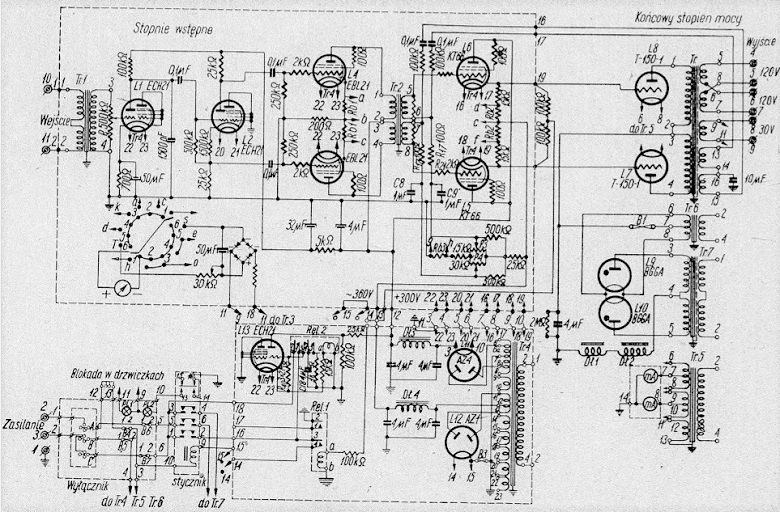
Schematic diagram of the WR-600 amplifier
- FROM RADIO AMATEURS PRACTICE (23)
"Electricity meter as a wattmeter.
Improved method of detecting unmodulated telegraphy in superheterodyne.
Radioamator (Radio Amateur) 1955/01
- Details
- Category: Radioamator
- Hits: 2096
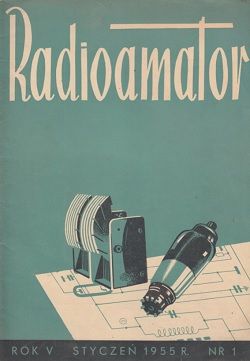
- MEMBERS OF LPŻ (League of Friends of a Soldier) AT LENINGRAD'S COMPETITION - M. Konieczny (1)
"On November 12 last year, a team of Elpetrators flew from Warsaw to Leningrad for the International Radiotelegraphist Competition, which took place on November 18-26. The team consisted of six players and three management..."
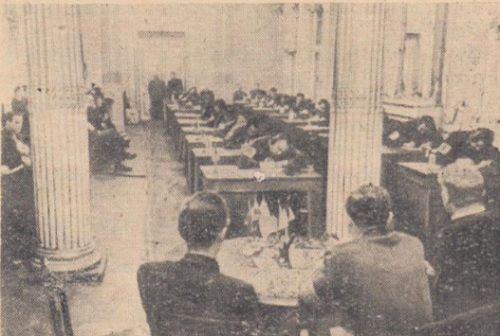
General view of the competition hall - Reception competition with manual registration.
- IMPLEMENTATION OF THE TRAINING OPERATION PLAN FOR LPŻ (League of Friends of a Soldier) - M. Rybak (3)
"The planned economy provides us with a rapid increase in the country's industrialization and agricultural production, intensive reconstruction of the damage, dissemination of science, inflow of qualified personnel and many other achievements. The full-time employees and social activists of the LPŻ Voivodship Boards are generally aware of the importance of the full implementation of the training plan and the preparation of new communication personnel for the needs of the national economy and national defense..." - CONDENSER MICROPHONE - A. Musioł (4)
"A condenser microphone occupies one of the first places in electroacoustics, mainly due to its electrical properties and simple construction. It not only has an even frequency response in the range of 50 ÷ 10,000 Hz, but also introduces almost no non-linear distortions and practically has no sensitivity threshold. The noise level is determined only by the noise from the tubes and individual parts of the amplifier. Simplicity in construction, insensitivity to shocks, are the advantages that predestine a condenser microphone for use by radio amateurs, especially when it comes to obtaining high-quality sound reproduction, e.g. in megaphonization and reporting. Even the simplest types of microphones give satisfactory results, of course, provided that they are carefully made and important design principles are followed. The only disadvantage of the mentioned microphone is that, due to the need to reduce the input capacity, it requires a preamplifier located as close as possible to the microphone insert itself. It is advisable to place the microphone and the preamplifier in one common metal housing..."
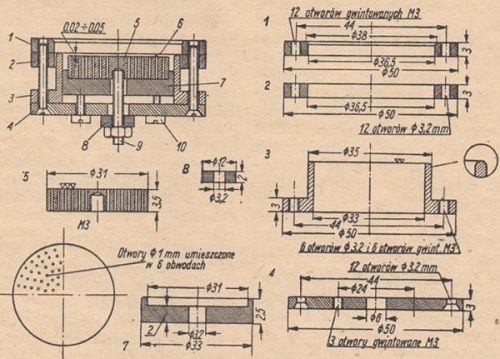
Condenser microphone design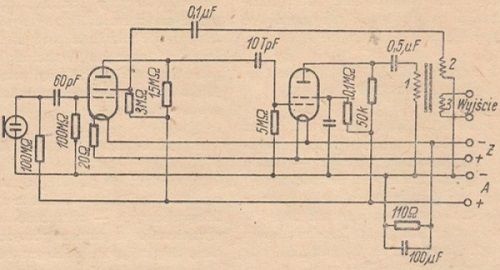
Two-stage microphone preamplifier based on subminiature battery tubes type CK506AX (or DL67)
- RADIO AT THE LIPBIAN FAIR - K. L. (9)
"This year's Leipzig Trade Fair has probably broken all records so far in terms of the number of exhibitors, attendance of visitors, concluded commercial transactions and exhibition space occupied. Representatives of many countries took part as exhibitors. A large radio pavilion gave an overview of the achievements of the GDR in the field of radio engineering..." - RECEIVER OF ADVANCED SHORTWARD (part II) - W. Nietyksza SP5FM (10)
"The heptode part of the ECH21 tube works as an intermediate frequency amplifier of 85 kHz. The voltage RW is also applied to it. The screen is powered by a 47 kΩ resistor and blocked for high frequency. with a 50 T pF capacitor. In the anode there is a filter similar to the previous one. with adjustable feedback..." - FIVE BANDS WITHOUT SWITCH - Z. Bieńkowski SP7LB (12)
"The normally used anode circuit allows the final stage to be tuned within relatively small limits. If C is an ordinary rotary capacitor with capacities Cmax - 450 pF and Cmin - 10 pF, and the assumed mounting capacity together with the output of the lamp Cdod - 40 pF..."
Radioamator (Radio Amateur) 1955/11
- Details
- Category: Radioamator
- Hits: 2184
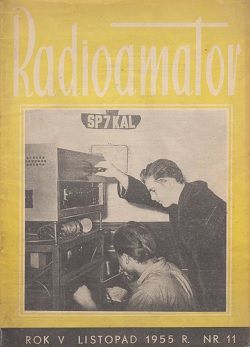
- At the finish of the six-year plan (1)
"We are only a month away from the final completion of the great and glorious work - the 6-year Plan. It is as if a few steps to the finish line of the entire nation's sacrificial race of work. In a few weeks, a considerable section of the road will be behind us, on which we had to overcome the many, often difficult, difficulties. Approaching the finish line, and then looking back at the time-consuming and exhausting stage of our peaceful construction - we will undoubtedly do what the custom does not need to remind a good host:... " - Let's learn radio engineering: Ways to protect electrical equipment against harmful radio interference (2)
"In this article, we will discuss the technical means by which radio interference is fought at the very source of their occurrence, that is, with all kinds of power devices that cause either periodic or periodic interruption of current, or abrupt changes in current in electric network cables (in the previous article already explained why such current surges are the source of radio interference)..." - Practical problems of amateur radiotelephony, part III (4)
"Grid modulation with carrier wave regulation
As already mentioned - the low average energy efficiency of a modulated amplifier in the grid can be increased by using so-called regulation (control) of the carrier wave level (carrier control). In conventional modulation systems - the power of the carrier wave itself is constant and does not depend on the presence of modulating voltage. The average depth of modulation is small, the transmitter is fully modulated only at moments, and already in the intervals between words or syllables the carrier wave is sent to the "ether" completely useless..." - Soviet equivalent of R-type electron tubes (6)
"RGN564 ÷ BO!, RGN2004 ÷ BO116/BO188, RGN1064 ÷ BO125/BO197/BO202..." - ZSW-2 control unit (8)
"Slowly but surely - the range of equipment manufactured by our industry for the needs of wired radio is expanding. Among other things, the ZSW-2 power amplifier control unit has already been used, its schematic diagram is shown in the figure. This set includes: a receiver, a microphone amplifier, a power supply and a control speaker.
A radio program or local broadcast (microphone, adapter) can be transmitted via the control unit. The control loudspeaker allows you to tune the receiver and control the broadcast while the radio is operating..."
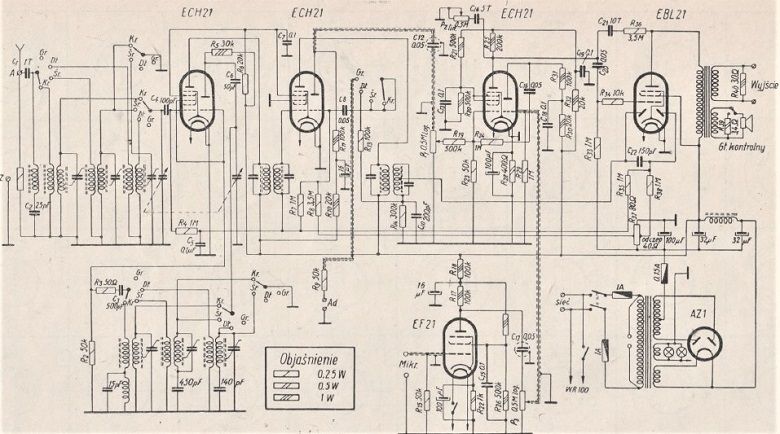
- From the competition "Polni Den" 1955 - SP9KAG on Velka Raca (10)
"Gliwice Communications Club prepared three teams for "Polni Den", which were to take part in the competition under the signs SP9KAG, 9UAO, 9OAR for the first time. Because the club's VHF section was established only a few months ago and we didn't have any experience in this field, it was decided to work during the competition only in the 144 MHz band as the easiest to master..."
DC power amplifier RA360ST (1934 r.)
- Details
- Category: Articles
- Hits: 2084
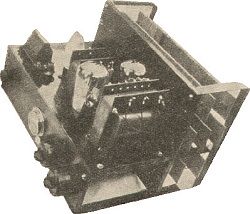
Renat Terlecki,DC power amplifier, Antena 1934/11
Radio engineering has recently gained a completely new field of activity in the form of high power loudspeaker installations. Apart from the film of high-power loudspeaker installations, we also often meet in a wide range of public utilities such as train stations, guest houses, hotels, sports grounds, concert halls, even churches and parliaments.
Several years of practice crystallized the concept of a modern power amplifier and today we require from such a device:
- Complete electrification.
- Uniform gain and reproduction of a wide frequency range.
- Versatile use, i.e. for both the adapter and the microphone, photocells, radio and so on.
- High efficiency possible.
- Transparent design.
- Simple operation and minimal maintenance, and finally
- Carefully fitted equipment.
However, all this is successful when we have an AC source available, usually in the form of a lighting network. Alternating current, as we know, can be transformed into any high or low voltage; so we can build economical filament circuits without losses on reducing resistors, and having any high anode voltage we use more efficient systems, eg "class C", i.e. directly coupled.
In many cities, however, we have power plants, supplying lighting or industrial DC, and in this case building a high power amplifier, we face special difficulties. In fact, for the reasons given above, high power amplifiers are usually calculated on the power network. variable, so wanting to power them from the power grid fixed, we must use converters whose cost for small installations may exceed the value of the amplifier. So sometimes it pays to give up the economics of the system and settle for a relatively high power amplifier with a very low anode voltage of 150 ÷ 200 Volt.
The amplifier described below is designed for a 250 ÷ 150 Volt DC power supply. Understandably, by reducing the value of the main reduction resistance "R" we can connect the amplifier to a network with a lower voltage, but then the output stage power would drop too much.
SCHEMATIC DIAGRAM
Before we get to our amplifier, let's start by studying the most important system - the filament circuit. This circuit, as we can see from the simplified diagram in Fig. 1, consists of adjustable resistance R5, at whose ends, according to Ohm's law, the flowing current (1.4 Amp.) Creates the potential difference "Eg", used here as the negative pre-grid of output tubes. Then the filament current branches off after 0.65 Amp. on two cathodes of output tubess in parallel. The rest of the current, according to Kirchhoff's law, flows through the regulated shunt resistance R4, which regulates the filament voltage of both tubess. Then again, the sum of the filament current flows through the heater of the indirectly-heated input tube (ca 1 Amp.), whose heater is controlled by the R3 shunt resistance. Next we have an iron - hydrogen tube "1331" automatically regulating the filament current to 1.3A - and finally the main reduction resistance R.
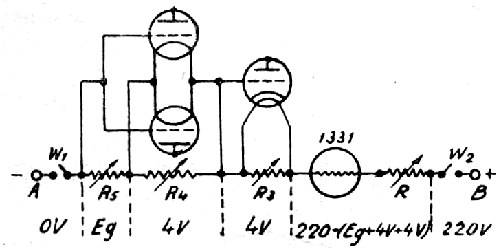
Fig.1
It should be noted that the sum of resistance of this circuit between points A and B must be a constant value for a given network voltage. Not very large fluctuations in the network voltage and changes in R5 and R resistances will automatically compensate the resistance of 1331 tube, however, e.g. larger changes in R5 resistance must be compensated with R resistor. As for the essential part of the amplifier, as we can see from the complete diagram in Fig. 2, it is very simple.
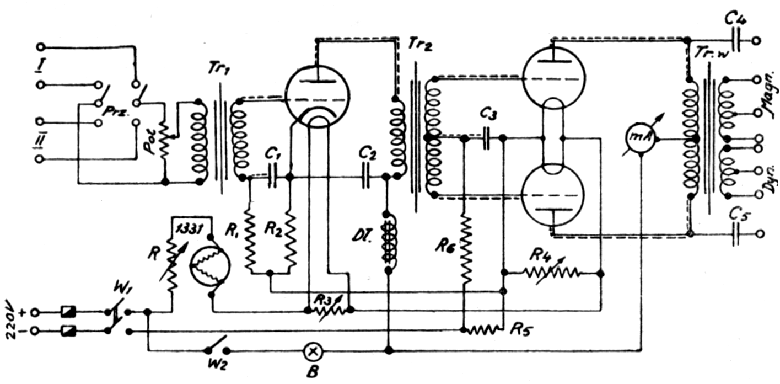
Fig.2
At the input we have a switch that allows you to quickly transfer the amplifier from one pair of input sockets to another. From the switch, the current of audible frequency runs through the Pot potentiometer, regulating the force, from where it goes to the primary winding of the transformer Tr1, whose secondary winding is the grid circuit of the amplifier's input tube. The potentiometer can be successfully lowered if the audible current source (adapter-microphone) used has its own power regulation. The resistance R2 inserted into the cathode circuit of the first tube gives it the necessary negative pre-netting. The input tube anode through the primary winding Tr2 is connected to the choke Dl, which together with the C2 capacitor is used to smooth the pulsation of the network current. The Tr2 secondary winding has three terminals.
Page 1 of 4



